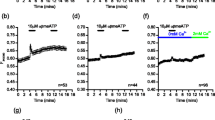Abstract
ATP IS one of several agonists which stimulate Ca2+-dependent exocytotic degranulation of mast cells, causing the release of histamine and other mediators of immediate hypersensitivity1–3. The concentration–effect relationship of ATP on mast cells is characterised by the sharp onset of self-inhibition as the concentration is raised above the optimum for histamine secretion4. We have previously shown that stimulation of mast cells with IgE-directed ligands (antigen, concanavalin A), chymotrypsin and compound 48/80 is accompanied by an increased turnover of phosphatidylinositol5 similar to that observed for Ca2+-mediated responses in other tissues6. At concentrations of ATP which cause inhibition we have observed a reduction in phosphatidylinositol turnover to less than control levels (unpublished results). We show here that the inhibition by ATP is correlated with an extensive leakage of phosphorylated metabolites from the cells.
Similar content being viewed by others
References
Keller, R. Tissue Mast Cells in Immune Reactions, 38–39 (Karger, Basle, 1966).
Sugiyama, K. Jap. J. Pharmac. 21, 209–226 (1971).
Dahlquist, R. & Diamant, B. Acta pharmac. tox. 34, 368–384 (1974).
Cockcroft, S. & Gomperts, B. D. (submitted).
Cockcroft, S. & Gomperts, B. D. Biochem. J. 178, 681–687 (1979).
Michell, R. H., Jafferji, S. S. & Jones, L. M. Adv. exp. Biol. Med. 83, 447–465 (1977).
Grosman, N. & Diamant, B. Ag. Actions 5, 108–114 (1975).
Peterson, C. & Diamant, B. Acta pharmac. tox. 34, 325–336 (1974).
Bartlett, G. R. J. biol. Chem. 234, 459–465 (1959).
Wahler, B. E. & Wollenberger, A. Biochem. Z. 329, 508–520 (1958).
Rozengurt, E., Heppel, L. A. & Friedberg, L. J. biol. Chem. 252, 4584–4590 (1977).
Dahlquist, R. Acta pharmac. tox. 35, 11–22 (1974).
de Kruijff, B. & Demel, R. A. Biochim. biophys. Acta 339, 57–70 (1974).
Baumann, G. & Mueller, P. J. supramolec. Struct. 2, 538–557 (1975).
Rose, B. & Loewenstein, W. R. Nature 254, 250–252 (1975).
Rose, B., Simpson, I. & Loewenstein, W. R. Nature 267, 625–627 (1977).
Fewtrell, C. M. S. & Gomperts, B. D. Biochim. biophys. Acta 469, 52–60 (1977).
Author information
Authors and Affiliations
Rights and permissions
About this article
Cite this article
COCKCROFT, S., GOMPERTS, B. ATP induces nucleotide permeability in rat mast cells. Nature 279, 541–542 (1979). https://doi.org/10.1038/279541a0
Received:
Accepted:
Published:
Issue Date:
DOI: https://doi.org/10.1038/279541a0
- Springer Nature Limited
This article is cited by
-
Antagonism of the ATP-gated P2X7 receptor: a potential therapeutic strategy for cancer
Purinergic Signalling (2021)
-
P2X7 is a cytotoxic receptor….maybe not: implications for cancer
Purinergic Signalling (2021)
-
Blocking P2X7 receptor ameliorates oxidized LDL-mediated podocyte apoptosis
Molecular Biology Reports (2019)
-
Extracellular purines, purinergic receptors and tumor growth
Oncogene (2017)
-
Purinergic signaling in inflammatory cells: P2 receptor expression, functional effects, and modulation of inflammatory responses
Purinergic Signalling (2013)





